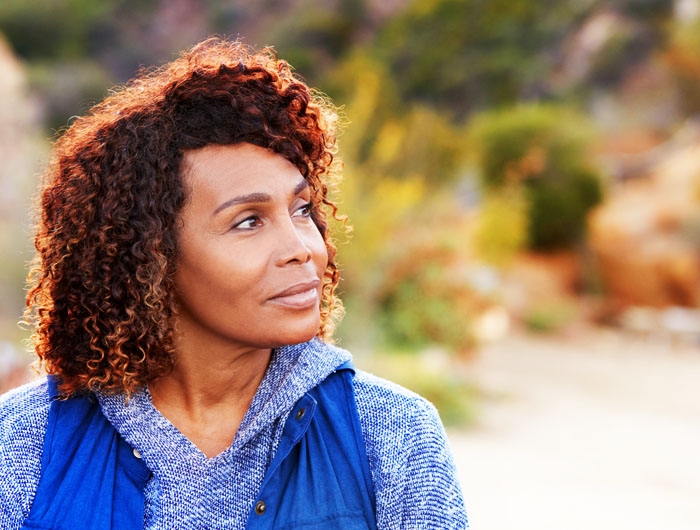About 4 in 10 cancers are preventable. Here's how to lower your risk.

Monkey Business - stock.adobe.com.
Roughly 40 percent of cancers are preventable, say experts. That means avoiding tobacco and limiting excess weight, alcohol, inactivity, and an unhealthy diet. Vaccines and screening also matter. Here’s what to know.
Click on a link to jump to a specific section:
- Breast cancer
- Colorectal cancer
- Esophageal cancer
- Liver cancer
- Lung cancer
- Ovarian cancer
- Pancreatic cancer
- Prostate cancer
- Uterine cancer
- 10 tips to reduce your risk of cancer
U.S. death rates from most major cancers

Top cancer killers

Breast cancer

Breast cancer is the No. 1 cause of cancer in U.S. women. While the rate of new cases has crept up since the mid-2000s, death rates have dropped 43 percent since 1989.
You have a higher risk of breast cancer if you:
- are postmenopausal
- have excess weight (and you’re postmenopausal)
- are sedentary
- consume alcohol often
- have a relative—especially a mother, sister, or daughter—who was diagnosed with breast cancer
- have mutations in genes (like BRCA1 and BRCA2) found in families with high rates of breast cancer
- had menstrual periods that began before age 11 or menopause that began after age 55
- had no children or were older than 30 when you had your first child
- took estrogen and progestin after menopause (the risk diminishes after you stop)
- have dense breast tissue (seen on a mammogram)
- have abnormal breast cells (atypical hyperplasia or ductal carcinoma in situ)
What can lower your risk of breast cancer
You can’t change your age, genes, or breast cells. But you can lower your risk.
“After menopause, women who have excess weight have a higher risk of breast cancer,” says Heather Eliassen, professor of nutrition and epidemiology at the Harvard T.H. Chan School of Public Health.
Why? “Estrogens are drivers of the most common type of breast cancer,” she explains. “After menopause, the ovaries no longer produce estrogen, but androgens continue to circulate, and they get converted into estrogen in fat tissue. So the more weight a woman carries, the higher her circulating levels of estrogens.”
Exercise can help lower risk, and not just by keeping weight down.
“Physical activity may also lower risk by reducing high blood insulin levels and inflammation,” notes Eliassen. “Even brisk walking is beneficial. You don’t have to run marathons.”
In contrast, “alcohol increases risk, even with quite low consumption levels.”
Compared to nondrinkers, women who have three to seven drinks a week have a 10 percent higher risk and those who have at least two drinks a day have a 30 percent higher risk.
“Alcohol may increase susceptibility to DNA damage, contribute to oxidative stress, and increase levels of estrogen,” explains Eliassen.
Carotenoid-rich green, orange, or red vegetables and fruit, on the other hand, may protect against breast cancer, even in women at high risk.
“Carotenoids are potent antioxidants,” says Eliassen, “but other bioactive compounds in those fruits and vegetables may also lower risk.”
Likewise, women who eat a diet rich in healthy plant foods (whole grains, fruits, vegetables, nuts, legumes, vegetable oils, tea, and coffee)—not unhealthy plant foods (fruit juices, sugary drinks, refined grains, potatoes, and sweets)—have a lower risk, especially when it comes to tumors that aren’t driven by estrogen.
And that matters, because “estrogen receptor-negative tumors are more aggressive and harder to treat,” Eliassen points out.
Warning signs of breast cancer
- a painless lump in the breast or underarm area
- Less-common symptoms: breast pain or heaviness, thickening, swelling, redness, discharge, nipple turned inward
Colorectal cancer

The good news: Death rates from colorectal cancer have been cut in half since 1970, thanks largely to screening and better treatment. The bad news: Death rates are rising in adults under 55.
You have a higher risk of colorectal cancer if you:
- are 45 or older
- have excess weight
- are sedentary
- eat processed or red meats often
- have 2 or more servings of alcohol a day
- have a parent, brother, sister, or child who was diagnosed with colorectal cancer
- have ever had colon polyps
- have ulcerative colitis or Crohn’s disease
- have type 2 diabetes
- smoke tobacco
What can lower your risk of colorectal cancer
“It’s looking like at least half of all colorectal cancers can be prevented through lifestyle,” says Amanda Cross, professor of cancer epidemiology at Imperial College London.
Among the key culprits: excess weight, red and processed meats, alcohol, smoking, and inactivity.
Cross’s earlier work showed that feeding people red meat can create carcinogenic N-nitroso compounds in the gut.
That was just one piece of evidence that led the International Agency for Research on Cancer to conclude that processed meat (like bacon, ham, sausages, and lunch meats) is a human carcinogen, while unprocessed red meat is a “probable” human carcinogen.
Now there’s a new clue. After analyzing tissue samples from 900 people with colorectal cancer, scientists have identified a distinct pattern of DNA damage—known as an “alkylating mutational signature”—in some tumors.
“We found that the frequency of this alkylating signature was higher in tumor samples of patients with very high red and processed meat intake when compared to those with very low intake,” noted Kana Wu, principal research scientist at the Harvard T.H. Chan School of Public Health, in a 2021 online presentation on Oncology Tube. (Wu is now at Vertex Pharmaceuticals.)
Those kinds of signatures are like fingerprints left by a criminal at a crime scene. (Tobacco smoke, for example, also has distinct mutational signatures.)
That said, noted Wu, the findings need to be confirmed.
Meanwhile, scientists are scrambling to figure out why colorectal cancer is climbing in younger adults worldwide.
That increase explains why experts now recommend screening starting at age 45. You can choose from stool detection kits, a CT scan, a colonoscopy, and more.
Warning signs of colorectal cancer
- diarrhea or constipation
- feeling that your bowel doesn’t empty completely
- blood (very dark) in your stool
- rectal bleeding
- narrow stools
- gas pain
- cramps
- feeling full or bloated
- unintended weight loss
- fatigue
- decreased appetite
Esophageal cancer

Since 2000, esophageal squamous cell cancer rates have been dropping, but rates of esophageal adenocarcinoma have not. The 5-year survival rate for both (20 percent) is dismal.
You have a higher risk of esophageal cancer if you:
- are over 55
- have excess weight
- are male
- smoke or chew tobacco
- have acid reflux or Barrett’s esophagus
- are a heavy drinker
What can lower your risk of esophageal cancer
What’s the best way to cut your risk of both types of esophageal cancer?
“Number one is to stop smoking,” says Christian Abnet, chief of the metabolic epidemiology branch at the National Cancer Institute.
To dodge squamous cell cancers, avoiding excess alcohol is also key.
However, “esophageal adenocarcinoma is now the more dominant type in the United States,” notes Abnet. And it’s linked to excess weight.
“In heavier people, there may be more pressure on the esophageal sphincter, so it’s more likely to be open and lead to reflux,” he explains.
And gastro-esophageal reflux disease, or GERD, may set the stage for cancer.
“The stomach contents are typically acidic and can contain digestive enzymes from the small bowel,” says Abnet.
“The glandular cells in your stomach and colon are prepared for the exposure to those caustic agents, but the squamous cells in your esophagus are not. So with reflux, you can get damage to those cells.”
Do drugs that curb reflux lower your risk of cancer?
“There’s never been a full-scale trial,” says Abnet. “It would be very difficult to run a study, because the number of people with GERD is large, but the number of those people who actually develop esophageal adenocarcinoma is small.” And that’s good news.
Warning signs of esophageal cancer
- painful or difficult swallowing
- chest pain
- unintended weight loss
- hoarseness
- cough
- vomiting
- bone pain
- black stools
Liver cancer

Liver cancer cases tripled from 1980 to 2015, and death rates doubled over roughly the same time. Since then, both have stayed fairly stable.
You have a higher risk of liver cancer if you:
- have chronic hepatitis B or C infection
- have excess weight
- have type 2 diabetes
- are a heavy drinker
- smoke tobacco
What can lower your risk of liver cancer
“Increasingly, the most important risk factor for liver cancer is non-alcoholic fatty liver disease,” says Katherine McGlynn, senior investigator in the metabolic epidemiology branch at the National Cancer Institute. And one out of three U.S. adults has it.
“So the message is to maintain a reasonable weight, because when you have more body fat, you tend to get fat deposition in the liver,” notes McGlynn. “And it’s not simply weight, but waist circumference, that matters.”
How does that lead to cancer? “It’s not well understood,” says McGlynn.
How the hepatitis B virus can cause cancer is clearer. The virus integrates into the DNA of liver cells, where it can cause mutations that lead the cells to grow abnormally and uncontrollably.
“The hepatitis B vaccine has been part of standard pediatric immunization since the 1980s, so we hope the virus will go out of existence in the U.S.,” says McGlynn.
Anyone under age 60 who’s unvaccinated—or over 60 with risk factors—should also get the vaccine. (For a list of risk factors, see CDC.gov/hepatitis.)
There is no vaccine for hepatitis C, but it’s curable. That’s why the Centers for Disease Control and Prevention advises all adults to get tested.
“The virus hasn’t been in the blood supply since 1990, but there’s some concern because of the opioid epidemic,” explains McGlynn. “Exposure to hepatitis C goes up when people use IV drugs.”
Of course, excessive alcohol consumption is a known cause of liver cancer.
Whether it’s alcohol, a virus, or a fatty liver, “all causes of liver cancer go through the same process,” says McGlynn. “They damage the liver, and when the liver tries to repair and replace the damaged cells, scarring—or fibrosis—can result. Severe scarring is cirrhosis.”
Some good news: “Coffee still looks promising,” says McGlynn. “People who drink three or four cups a day have a lower risk of liver cancer.” (Note: a Starbucks venti is 2½ cups.)
“Studies also see a lower risk with decaffeinated coffee, so it’s not necessarily the caffeine,” she adds.
Warning signs of liver cancer
- bulge or hard lump below the rib cage on right side
- abdominal pain or swelling
- yellow skin or whites of eyes
- loss of appetite
- unintended weight loss
- fever
- nausea
- vomiting
Lung cancer

Lung cancer cases have been dropping since the mid-1980s in men and the mid-2000s in women. Yet it still kills far more Americans than any other cancer.
You have a higher risk of lung cancer if you:
- smoke or have smoked tobacco
- have had long-term exposure to radon, asbestos, diesel exhaust, air pollution, radiation, or secondhand smoke
What can lower your risk of lung cancer
It’s not just lung cancer. Smoking boosts the risk of a dozen cancers, including of the mouth, throat, larynx, esophagus, pancreas, cervix, kidney, bladder, stomach, colon and rectum, and liver plus acute myeloid leukemia.
But 20 percent of lung cancers strike people who never smoked. Why?
“Some are caused by secondhand smoke or radon,” says Abnet.
A greater fraction of lung cancers are now being diagnosed before they spread.
“We now have good evidence that yearly screening with a low-dose CT-scan can save lives,” notes Abnet. “And it’s covered by most health insurance.”
Screening is for people aged 50 to 80 who smoke or have quit within the past 15 years and have a 20 “pack-year” smoking history—that is, they smoked 1 pack a day for 20 years, 2 packs a day for 10 years, etc.
And inhaling any smoke, including from marijuana, is likely to harm lungs. You’re still getting tar and carbon monoxide.
“Some people may think that a water pipe filters the smoke,” says Abnet. “It doesn’t. The pipe just cools the smoke so it’s easier to hold in your lungs. That’s probably making it worse.”
Warning signs of lung cancer
- persistent cough
- shortness of breath
- chest pain
- coughing up bloody mucus
- hoarseness
- frequent lung infections like pneumonia
Ovarian cancer

Death rates have been inching down, but the 5-year survival rate is only 49 percent, largely because only one in five patients is diagnosed before the cancer has spread outside the ovary.
You have a higher risk of ovarian cancer if you:
- have a mother or sister who was diagnosed with ovarian or breast cancer
- have been diagnosed with breast cancer
- have mutations in genes (like BRCA1 and BRCA2) that are found in families with high rates of ovarian cancer
- took estrogen alone or with progestin after menopause (the risk diminishes after you stop)
- have excess weight
What else matters for your risk of ovarian cancer
“Oral contraceptives lower the risk of ovarian cancer,” says Shelley Tworoger, division chief of population science at the Moffitt Cancer Center in Tampa.
That’s largely because they keep you from ovulating.
“When an egg bursts through the lining of the ovary and goes into the fallopian tube, that’s accompanied by a bunch of inflammatory and growth factors,” explains Tworoger.
So the more times you ovulate, the higher your lifetime risk.
“The longer women are premenopausal, the more ovulations they have,” says Tworoger. “If they’re on oral contraceptives, if they’re pregnant, if they’re breastfeeding, that suppresses ovulation.”
However, taking hormones after menopause increases your risk.
“Anything that raises your blood hormone levels—oral pills, patches, injections—increases risk,” says Tworoger. That includes “bioidentical” hormones.
In contrast, “local remedies like vaginal creams are a safer way to treat menopausal symptoms because they don’t raise blood levels beyond the normal range,” adds Tworoger.
And if women are having a hysterectomy or looking for permanent contraception, they can get a salpingectomy—that is, having their fallopian tubes removed while leaving their ovaries intact, so there are no side effects.
“Removing the fallopian tubes reduces risk of ovarian cancer by 50 to 60 percent,” says Tworoger.
That’s because many ovarian cancers arise from the cells in the fallopian tube that spread to the ovary.
“There’s some evidence that talc increases the risk of ovarian cancer in women with an intact reproductive system,” notes Tworoger. “But it’s difficult to know if powders contain talc because it’s often a contaminant. So it’s safest to just not use powders in the perineal area.”
One more tip: Don’t ignore possible symptoms of ovarian cancer.
“Almost all women who are diagnosed with ovarian cancer have symptoms prior to their diagnosis, and they tend to be persistent,” says Tworoger.
“If you have bloating, an urgency to urinate, or other warning signs and don’t find relief, talk to your doctor about having an ultrasound.”
Warning signs of ovarian cancer
- abdominal swelling
- persistent bloating
- pain in the abdomen, back, or pelvis
- the need to urinate often or urgently
- feeling full quickly
Pancreatic cancer

Pancreatic cancer accounts for just 3 percent of cancer diagnoses. But it’s the No. 4 cancer killer in both men and women, because only 11 percent of patients survive for five years.
You have a higher risk of pancreatic cancer if you:
- have a parent or sibling who was diagnosed with pancreatic cancer
- have excess weight
- have type 2 diabetes
- smoke or chew tobacco
- have chronic pancreatitis
What else matters for your risk of pancreatic cancer
“Pancreatic cancer is insidious because the pancreas can harbor a tumor that grows without any clue,” says Meir Stampfer, professor of epidemiology and nutrition at the Harvard T.H. Chan School of Public Health.
“And there’s no capsule around the organ itself, so cancer cells can easily spread. Once the cancer starts causing symptoms, life expectancy is fairly short.”
Why has the number of cases crept up since 2000? “It’s most likely due to weight gain, because smoking is also an established risk factor and that’s been going down,” says Stampfer.
It’s not just excess weight, but excess waist, that matters. In contrast, unintentional weight loss, as well as diabetes, may be a sign of the disease.
“The cancer may be causing these metabolic changes before a diagnosis but after the tumors are there,” says Stampfer. “In the future, those clues might lead to better screening methods.”
Warning signs of pancreatic cancer
- abdominal pain that may radiate to the back
- yellow skin and eyes
- unintended weight loss
- nausea
- vomiting
Prostate cancer

Prostate cancer is common, but the 5-year survival rate is close to 100 percent, except for men with distant-stage cancer. Their survival rate drops to 31 percent, and the number of distant cancers is climbing.
You have a higher risk of prostate cancer if you:
- are over 50
- have a father, brother, or son who was diagnosed with prostate cancer
- are of African ancestry
What else matters for your risk of prostate cancer
“If you do random biopsies of older men, you’ll find prostate cancer in about a third of them, and it doesn’t cause any problem unless it’s treated,” says Stampfer.
Treatment can lead to erectile dysfunction or urinary incontinence.
That’s one reason the U.S. Preventive Services Task Force recommends that men aged 55 to 69 “discuss the potential benefits and harms” of getting a PSA test to find out if they might have prostate cancer, and that doctors “should not routinely screen men 70 years and older.”
What to know if you’re on the fence: “One has to break that automatic link between a high PSA and treatment,” says Stampfer.
“If your PSA is 1 at age 65, I would stop getting tested. You’re not going to die of prostate cancer.”
And if your PSA is elevated, you might not need a biopsy right away.
“Inflammation can raise PSA levels,” says Stampfer. “If you wait a few months, it might go down.”
Even if a biopsy finds cancer, “that doesn’t mean the cancer needs treatment,” he adds. “Most do not. But a biopsy can identify tumors that need treatment to avoid metastatic disease.”
Warning signs of prostate cancer
- weak or interrupted urine flow
- difficulty starting or stopping urine flow
- need to urinate often, especially at night
- sudden urge to urinate
- blood in the urine
- pain or burning with urination
- pain in the back, hips, or ribs that doesn’t go away
Uterine cancer

The incidence of an aggressive type of uterine cancer has been increasing dramatically since 2000, especially in Black women. Its cause is a mystery.
You have a higher risk of uterine cancer if you:
- have excess weight
- are sedentary
- started menopause after age 55
- took estrogen without progestin after menopause
- have type 2 diabetes
What can lower your risk of uterine cancer
“Uterine cancer comes in two main varieties—endometrioid and nonendometrioid,” says Immaculata De Vivo, professor of epidemiology at the Harvard T.H. Chan School of Public Health.
“Nonendometrioid is the more aggressive type, and it affects women of color disproportionately.”
Endometrioid cancers account for 75 percent of cases. They’re usually diagnosed at an early stage—because of bleeding or spotting—and the 5-year survival rate is 92 percent.
“The most common risk factor for endometrioid cancer is obesity,” notes De Vivo. That’s largely because endometrioid cancer is fueled by estrogen.
“When you’re postmenopausal, fat cells serve as a source of estrogen,” explains De Vivo.
What lowers risk? “Physical activity, even brisk walking, is beneficial,” says De Vivo.
And in De Vivo’s recent analysis, which pooled data from 19 studies worldwide, women who drank two to three cups of coffee a day had a 14 percent lower risk of uterine cancer than those who drank none. And those who drank four cups a day had a 24 percent lower risk. (It’s too early to say whether decaf helps.)
“Coffee may lower levels of estrogen and insulin, which are both implicated in endometrioid cancer,” says De Vivo.
But obesity has less impact on nonendometrioid cancer, and researchers haven’t looked at exercise or coffee.
Nonendometrioid accounts for 15 to 20 percent of uterine cancers, and its 5-year survival rate is only 58 percent.
“We have a grant to look at over 3,000 women, mostly women of color, to understand why nonendometrioid cancer disproportionately impacts them,” says De Vivo.
“We’re going to look at tumor genetics, lifestyle, and more.”
Warning signs of uterine cancer
- abnormal vaginal bleeding or spotting
- discharge
- pain during sex, while urinating, or in the pelvic area
The 13 cancers linked to overweight or obesity

The bottom line

10 tips to reduce your risk of cancer:
- Stay away from tobacco.
- Limit alcohol to two servings a day for men or one for women. The less you drink, the better.
- Lose (or don’t gain) excess weight.
- Limit red and processed meats.
- Fill half your plate with vegetables or fruit.
- Shoot for 20 to 40 minutes a day of exercise that speeds up your heart rate.
- Apply a shot-glass-worth of “broad spectrum” sunscreen (SPF 30+) every 2 hours you’re in the sun. Avoid tanning beds.
- Anyone aged 9 to 26 should get HPV (human papillomavirus) vaccines to prevent cancers of the cervix, throat, vagina, penis, and more.
- Check the American Cancer Society’s guidelines for when to get a colonoscopy, mammogram, or other screening tests.
- For more information, go to the National Cancer Institute or the American Institute for Cancer Research.
Tags
Topics
More on cancer
A snapshot of the latest research on diet, exercise & more
Preventing Disease

A snapshot of the latest research on diet, exercise, and more
Preventing Disease

Take our quiz to help you stay healthy
Preventing Disease

Colorectal cancer: 5 ways to cut your risk
Preventing Disease

Can a healthy diet lower the risk of breast cancer recurring?
Preventing Disease


